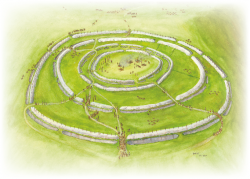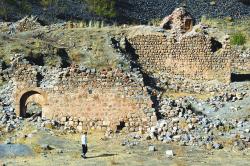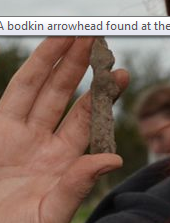INSTITUT SUPERIEUR D'ANTHROPOLOGIE
INSTITUTE OF ANTHROPOLOGY
ONLINE COURSES / COURS A DISTANCE
SUMMER TERM : JULY 2014
REGISTER NOW
ROYAUME UNI –  Whitehawk- The secrets of the community behind “Whitehawk’s Stonehenge” are set to be uncovered. The project will attempt to learn more about the community who created the Whitehawk Camp monument 5,500 years ago – half a millennium before the more famous Stonehenge in Wiltshire. The site was excavated in the 1920s and 1930s and marks the emergence of Britain’s first farming communities.The project will look to promote the significance of the monument and work on improving the site and its archive.The prehistoric project will also use the latest digital media technology and create an archaeological archive report.For more details visit www.ucl.ac.uk/caa/whitehawk-hlf.
Whitehawk- The secrets of the community behind “Whitehawk’s Stonehenge” are set to be uncovered. The project will attempt to learn more about the community who created the Whitehawk Camp monument 5,500 years ago – half a millennium before the more famous Stonehenge in Wiltshire. The site was excavated in the 1920s and 1930s and marks the emergence of Britain’s first farming communities.The project will look to promote the significance of the monument and work on improving the site and its archive.The prehistoric project will also use the latest digital media technology and create an archaeological archive report.For more details visit www.ucl.ac.uk/caa/whitehawk-hlf.
http://www.theargus.co.uk/news/11161787.Secrets_of_Whitehawk_Stonehenge_to_be_revealed/?ref=nt
TURQUIE – 
 Hogeacvank - The historic Hogeacvank Monastery, which was built in the 8th century with 22 rooms, can only be reached after a four hour journey on foot. The monastery is located in the Çatak district of the southeastern province of Van, which also draws attention for its many other religious structures. The structures, which have long been banned to visitors for safety reasons caused by terror events in the region, were opened to visitors after the peace process was initiated. The Hodeacvank Monastery, which can be reached after a four-hour walk from the village of Bilgi, is 130 kilometers from Van and known as the Der Meryem Church by locals, is now trying to find its way as a new tourism spot. The monastery was targeted by treasure hunters in the past, and although most of it has decayed because of neglect, it still dazzles for its architectural magnificence. Although the exact date of its establishment is unknown, the monastery is assumed to have been built in the 8th century and covers an area of some 2,000 square meters. A gate in the southern part provides entry. Van’s Yüzüncü Yıl University member Associate Professor Yalçın Karaca said the monastery complex includes the Vierge Marie Church, a chapel, and 22 rooms. “The formal historian of the 9th century Kingdom of Vaspurakan, Thomas Ardzruni, talks about the high priest of this church. Considering this information, it is possible to date the establishment of the monastery to before the 9th century. But it was not built in a heavily populated place, which is why it is not very well known by Armenians and locals,” Karaca said. He added that the monastery had been active for many years, as an icon of the Virgin Mary was kept there until the 19th century, and many people around the world had visited the monastery to see this icon. Noting that books had been written in the monastery between 14th and 16th centuries, Karaca said Armenian historians have suggested that four manuscripts, which are important for Christians, were written there. “It is now abandoned. We should know that such places could gain from tourism. The Van Lake basin is very rich in terms of Islamic and Christian faith and architecture. The monastery served as the episcopacy center of the Akdamar Church as of 1651,” he said.
Hogeacvank - The historic Hogeacvank Monastery, which was built in the 8th century with 22 rooms, can only be reached after a four hour journey on foot. The monastery is located in the Çatak district of the southeastern province of Van, which also draws attention for its many other religious structures. The structures, which have long been banned to visitors for safety reasons caused by terror events in the region, were opened to visitors after the peace process was initiated. The Hodeacvank Monastery, which can be reached after a four-hour walk from the village of Bilgi, is 130 kilometers from Van and known as the Der Meryem Church by locals, is now trying to find its way as a new tourism spot. The monastery was targeted by treasure hunters in the past, and although most of it has decayed because of neglect, it still dazzles for its architectural magnificence. Although the exact date of its establishment is unknown, the monastery is assumed to have been built in the 8th century and covers an area of some 2,000 square meters. A gate in the southern part provides entry. Van’s Yüzüncü Yıl University member Associate Professor Yalçın Karaca said the monastery complex includes the Vierge Marie Church, a chapel, and 22 rooms. “The formal historian of the 9th century Kingdom of Vaspurakan, Thomas Ardzruni, talks about the high priest of this church. Considering this information, it is possible to date the establishment of the monastery to before the 9th century. But it was not built in a heavily populated place, which is why it is not very well known by Armenians and locals,” Karaca said. He added that the monastery had been active for many years, as an icon of the Virgin Mary was kept there until the 19th century, and many people around the world had visited the monastery to see this icon. Noting that books had been written in the monastery between 14th and 16th centuries, Karaca said Armenian historians have suggested that four manuscripts, which are important for Christians, were written there. “It is now abandoned. We should know that such places could gain from tourism. The Van Lake basin is very rich in terms of Islamic and Christian faith and architecture. The monastery served as the episcopacy center of the Akdamar Church as of 1651,” he said.
http://www.hurriyetdailynews.com/remote-van-monastery-awaits-visitors.aspx?pageID=238&nid=65335
ROYAUME UNI –  Wark Castle - A community dig has shed new light on a castle which for centuries was in the front line of the conflict between England and Scotland. It has shown that Wark Castle on the Northumberland side of the River Tweed was more of a heavyweight prospect than previously believed. The excavations are the latest in a series by the Flodden 500 Archaeological project. The venture began in 2009 with a grant from English Heritage in the run-up to last year’s marking of the 500th anniversary of the Battle of Flodden. It was captured by the Scottish King James IV in August 1513, prior to the meeting of his army with the English at Flodden in the September. The 10-day dig tackled a field adjacent to the castle site, and uncovered the remains of a massive defensive wall five metres thick. In addition evidence was revealed of a second outer bailey area of the castle. “We have demonstrated that the castle is twice the size it has been supposed to have been,” said Chris Burgess, Flodden 1513 archaeology manager. “This helps us to understand why the castle was considered to be so important.” A dig by the project last year at Norham Castle on the Tweed also showed that it occupied a bigger area than was thought. Other finds at Wark included 13th and 14th Century pottery, an armour-piercing arrowhead and bones from butchered livestock. Wark Castle was built in the 12th Century and suffered several sieges and changing of hands between the English and the Scots. King Edward I and Edward III are believed to have stayed at the castle, and King Henry VI and his Queen Margaret sought refuge there after the Battle of Towton in 1461 in the War of the Roses. In 1513, James IV of Scotland failed to take Norham Castle but did manage to capture Wark. “The Scots did not want to bypass the castles because of the danger of the garrisons later attacking the supply lines of the Scottish army,” said Chris. After the English victory at Flodden, King Henry VIII turned Wark into an artillery fortification. “It marked a change in thinking, No longer was the castle a base from which some powerful individual ruled but instead it became a government fortification to stop the Scots crossing the River Tweed,” said Chris.The site is believed to have been the Scottish camp before the Battle of Flodden.
Wark Castle - A community dig has shed new light on a castle which for centuries was in the front line of the conflict between England and Scotland. It has shown that Wark Castle on the Northumberland side of the River Tweed was more of a heavyweight prospect than previously believed. The excavations are the latest in a series by the Flodden 500 Archaeological project. The venture began in 2009 with a grant from English Heritage in the run-up to last year’s marking of the 500th anniversary of the Battle of Flodden. It was captured by the Scottish King James IV in August 1513, prior to the meeting of his army with the English at Flodden in the September. The 10-day dig tackled a field adjacent to the castle site, and uncovered the remains of a massive defensive wall five metres thick. In addition evidence was revealed of a second outer bailey area of the castle. “We have demonstrated that the castle is twice the size it has been supposed to have been,” said Chris Burgess, Flodden 1513 archaeology manager. “This helps us to understand why the castle was considered to be so important.” A dig by the project last year at Norham Castle on the Tweed also showed that it occupied a bigger area than was thought. Other finds at Wark included 13th and 14th Century pottery, an armour-piercing arrowhead and bones from butchered livestock. Wark Castle was built in the 12th Century and suffered several sieges and changing of hands between the English and the Scots. King Edward I and Edward III are believed to have stayed at the castle, and King Henry VI and his Queen Margaret sought refuge there after the Battle of Towton in 1461 in the War of the Roses. In 1513, James IV of Scotland failed to take Norham Castle but did manage to capture Wark. “The Scots did not want to bypass the castles because of the danger of the garrisons later attacking the supply lines of the Scottish army,” said Chris. After the English victory at Flodden, King Henry VIII turned Wark into an artillery fortification. “It marked a change in thinking, No longer was the castle a base from which some powerful individual ruled but instead it became a government fortification to stop the Scots crossing the River Tweed,” said Chris.The site is believed to have been the Scottish camp before the Battle of Flodden.
http://www.thejournal.co.uk/news/north-east-news/community-dig-sheds-new-light-7012800
USA –  Baltimore - When Samuel Smith, major general of the Maryland militia, needed a headquarters to plot Baltimore's defense from British invaders in the summer of 1814, archaeologists believe he called on the owner of a shop that gives Butcher's Hill its name. Jacob Laudenslager leased much of what is Patterson Park today from landowner William Patterson, including a butcher's shop steps from where the park's iconic pagoda sits today. Archaeologists have uncovered a wall of that structure as they embark on a dig for a better understanding of what happened when thousands of militiamen camped along the hills of southeast Baltimore during the War of 1812. An excavation that began Wednesday has uncovered artifacts including bricks, mortar, glass, nails, shards of pottery and a gunflint — used to ignite gunpowder inside 19th century firearms.
Baltimore - When Samuel Smith, major general of the Maryland militia, needed a headquarters to plot Baltimore's defense from British invaders in the summer of 1814, archaeologists believe he called on the owner of a shop that gives Butcher's Hill its name. Jacob Laudenslager leased much of what is Patterson Park today from landowner William Patterson, including a butcher's shop steps from where the park's iconic pagoda sits today. Archaeologists have uncovered a wall of that structure as they embark on a dig for a better understanding of what happened when thousands of militiamen camped along the hills of southeast Baltimore during the War of 1812. An excavation that began Wednesday has uncovered artifacts including bricks, mortar, glass, nails, shards of pottery and a gunflint — used to ignite gunpowder inside 19th century firearms.
http://www.baltimoresun.com/news/maryland/baltimore-city/south-baltimore/bs-hs-patterson-park-dig-20140420,0,5535433.story#ixzz2zbUBhhJs